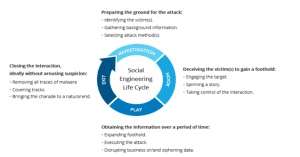
Social engineering is the term used for a broad range of malicious activities accomplished through human interactions. It uses psychological manipulation to trick users into making security mistakes or giving away sensitive information. These attacks aren’t limited to specific individuals or industries; rather, they target human vulnerabilities inherent in all of us. Prevention involves a combination of awareness training, robust security protocols, and technological defenses. Organizations must cultivate a culture of skepticism and encourage employees to verify requests and remain vigilant against potential threats, whether online or in-person. Through proactive measures and vigilance, we can mitigate the risks posed by social engineering tactics.
Social engineering attack life cycle
Social engineering attacks happen in one or more steps. A perpetrator first investigates the intended victim to gather necessary background information, such as potential points of entry and weak security protocols, needed to proceed with the attack. Then, the attacker moves to gain the victim’s trust and provide stimuli for subsequent actions that break security practices, such as revealing sensitive information or granting access to critical resources.

Social engineering attacking techniques
Social engineering attacks come in many different forms and can be performed anywhere where human interaction is involved. The following are the five most common forms of digital social engineering assaults.
BAITING
As its name implies, baiting attacks use a false promise to pique a victim’s greed or curiosity. They lure users into a trap that steals their personal information or inflicts their systems with malware.
- The most reviled form of baiting uses physical media to disperse malware. For example, attackers leave the bait—typically malware-infected flash drives—in conspicuous areas where potential victims are certain to see them (e.g., bathrooms, elevators, the parking lot of a targeted company). The bait has an authentic look to it, such as a label presenting it as the company’s payroll list.
- Victims pick up the bait out of curiosity and insert it into a work or home computer, resulting in automatic malware installation on the system.
- Baiting scams don’t necessarily have to be carried out in the physical world. Online forms of baiting consist of enticing ads that lead to malicious sites or that encourage users to download a malware-infected application.
SCAREWARE
- Scareware involves victims being bombarded with false alarms and fictitious threats. Users are deceived to think their system is infected with malware, prompting them to install software that has no real benefit (other than for the perpetrator) or is malware itself. Scareware is also referred to as deception software, rogue scanner software and fraudware.
- A common scareware example is the legitimate-looking popup banners appearing in your browser while surfing the web, displaying such text such as, “Your computer may be infected with harmful spyware programs.” It either offers to install the tool (often malware-infected) for you, or will direct you to a malicious site where your computer becomes infected.
- Scareware is also distributed via spam email that doles out bogus warnings, or makes offers for users to buy worthless/harmful services.
PRETEXTING
- Here an attacker obtains information through a series of cleverly crafted lies. The scam is often initiated by a perpetrator pretending to need sensitive information from a victim so as to perform a critical task.
- The attacker usually starts by establishing trust with their victim by impersonating co-workers, police, bank and tax officials, or other persons who have right-to-know authority. The pretexter asks questions that are ostensibly required to confirm the victim’s identity, through which they gather important personal data.
- All sorts of pertinent information and records is gathered using this scam, such as social security numbers, personal addresses and phone numbers, phone records, staff vacation dates, bank records and even security information related to a physical plant.
PHISING
- As one of the most popular social engineering attack types, phishing scams are email and text message campaigns aimed at creating a sense of urgency, curiosity or fear in victims. It then prods them into revealing sensitive information, clicking on links to malicious websites, or opening attachments that contain malware.
- An example is an email sent to users of an online service that alerts them of a policy violation requiring immediate action on their part, such as a required password change.
- It includes a link to an illegitimate website—nearly identical in appearance to its legitimate version—prompting the unsuspecting user to enter their current credentials and new password. Upon form submittal the information is sent to the attacker.
- Given that identical, or near-identical, messages are sent to all users in phishing campaigns, detecting and blocking them are much easier for mail servers having access to threat sharing platforms.
SPEAR PHISING
- This is a more targeted version of the phishing scam whereby an attacker chooses specific individuals or enterprises. They then tailor their messages based on characteristics, job positions, and contacts belonging to their victims to make their attack less conspicuous. Spear phishing requires much more effort on behalf of the perpetrator and may take weeks and months to pull off. They’re much harder to detect and have better success rates if done skillfully.
- A spear phishing scenario might involve an attacker who, in impersonating an organization’s IT consultant, sends an email to one or more employees. It’s worded and signed exactly as the consultant normally does, thereby deceiving recipients into thinking it’s an authentic message. The message prompts recipients to change their password and provides them with a link that redirects them to a malicious page where the attacker now captures their credentials.
SOCIAL ENGINEERING PREVENTION
Social engineers manipulate human feelings, such as curiosity or fear, to carry out schemes and draw victims into their traps. Therefore, be wary whenever you feel alarmed by an email, attracted to an offer displayed on a website, or when you come across stray digital media lying about. Being alert can help you protect yourself against most social engineering attacks taking place in the digital realm. Moreover, the following tips can help improve your vigilance in relation to social engineering hacks.
Don’t open emails and attachments from suspicious sources-
If you don’t know the sender in question, you don’t need to answer an email.
Use multifactor authentication–
One of the most valuable pieces of information attackers seek are user credentials. Using multifactor authentication helps ensure your account’s protection in the event of system compromise.
Be wary of tempting offers–
If an offer sounds too enticing, think twice before accepting it as fact.
Keep your antivirus/antimalware software updated–
Make sure automatic updates are engaged, or make it a habit to download the latest signatures first thing each day. Periodically check to make sure that the updates have been applied, and scan your system for possible infections.
How to detect a phishing email

CHECK THE “FROM” EMAIL ADDRESS FOR SIGNS OF FRAUDULENCE
Make sure to cross-check the email domain on any suspicious email. This is the name after the @ symbol in the email address. It should match the name and company of the attempted sender (be on the lookout for minor misspellings!).
WATCH FOR MISSPELLINGS AND INCORRECT GRAMMAR
Hackers and scammers tend to use online translation machines that don’t return perfect grammar or spelling, making misspellings and incorrect grammar common characteristics of phishing emails.
BE CAREFUL WITH ALL ATTACHMENTS — AND DO NOT OPEN QUESTIONABLE ONES
This might be the most important rule – do NOT open any attachments until you are 100% sure the sender is legitimate. If the email is indeed a phishing attack, the attachment will contain malware that will be exposed to your computer the second the document is opened.
PROTECT YOUR PERSONAL INFORMATION
Legitimate companies will never ask for sensitive or personal information over email.
- To check if your email or phone number is in a data breach you can check it out using this link haveibeenpwned.com then follow the procedures.
- You can also use virustotal.com to Analyze suspicious files, domains, IPs and URLs to detect malware and other breaches.
Conclusion
Social engineering poses a pervasive threat, exploiting human psychology to compromise security. From phishing to pretexting, attackers manipulate trust and emotions to extract sensitive information. Combatting these tactics requires awareness, skepticism, and proactive measures.
Schedule your social engineering assessment today to fortify your defenses against deceptive tactics. Get in touch with us to ensure the protection of your valuable data. Your security is our priority.”






